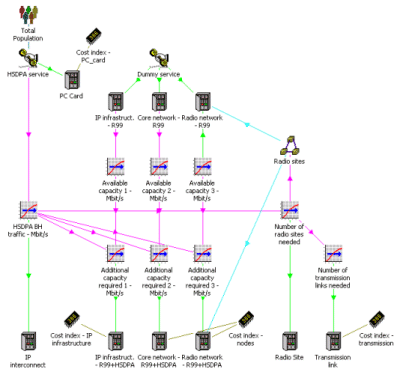 Operators are now starting to look at upgrading their basic 3G networks to support
new services such as mobile TV/video and high-speed Internet access. They therefore
need to determine whether there is a business case for such services, and the required
network enhancements to support them, for example through HSDPA (high-speed downlink
packet access).
Operators are now starting to look at upgrading their basic 3G networks to support
new services such as mobile TV/video and high-speed Internet access. They therefore
need to determine whether there is a business case for such services, and the required
network enhancements to support them, for example through HSDPA (high-speed downlink
packet access).
Ericsson has developed a comprehensive financial modelling tool for HSDPA. Using
their newly acquired D-STEM licence, Ericsson was able to develop a single financial
model that served the very different needs of two distinct groups of users: the
account managers, communicating directly with the operators globally, and the Business
Unit (BU).
Two distinct types of users, one model
The Ericsson WCDMA BU, located in Sweden, needed a discrete bottom-up financial
model that they could rely on to determine, amongst other things, the feasibility
of mobile broadband over WCDMA enhanced with HSDPA. Thus they needed a model that
separated out all of the elements of HSDPA, as well as other areas in an operator's
network that would be affected.
The account managers, on other hand, needed a model that was simple to populate
and drive in the presence of operators. They needed a model in which all the network
complexities were hidden – focusing on market data and the baseline network for the
operator – and that produced a predefined set of financial results that could be
shown to operators.
Model packaging using D-STEM
The Ericsson consulting group, located in Melbourne, Australia, was contracted by
the WCDMA BU to build a C-STEM financial model that would fulfil their requirements,
as well as an Excel version suitable for distribution to the account managers. However,
as is quite often the case, the resulting C-STEM model showed that what was being
modelled was much more complex than originally anticipated.
Furthermore, it became apparent that the preparation of an Excel version would be
by no means an easy task. Fortunately for Ericsson consulting, the recently purchased
D-STEM licences meant that they were able to avoid the gruesome task of rebuilding
the model in Excel. The consulting group convinced the WCDMA BU that a suitably
packaged D-STEM version of their model could fulfil the requirement of the account
managers. They called this package “Mobile Broadband in a Box” (MBiaB) and explained
that it had the following advantages:
- Does not require user installation of STEM
- Uses an Excel interface, hiding all STEM complexities
- All inputs and outputs are contained on one Excel spreadsheet
- The user is able to run the model by hitting a run button in Excel
- Eliminates Excel cell errors by using STEM
- Only one (STEM) model to maintain
- Drop-down menus in Excel to produce many types of results (as in C-STEM).
Modelling complexities
The MBiaB model built was a 10-year model, with the base year depicting the operator’s
current (R99) network and the introduction of an "HSDPA service" sometime thereafter.
Exhibit 1 below gives a simplified version of the HSDPA STEM model used in the MBiaB
package:

Simplified HSDPA STEM model (Source: Ericsson)
From the figure above, it can be seen that forecast HSDPA demand is met firstly
through existing R99 resource capacities and then through the deployment of new
HSDPA resources. The introduction of the HSDPA service has an impact on the operator’s
core and radio networks, as well as on the transmission link requirements, IP transport
infrastructure, and IP interconnect costs.
The model built included resource lifecycle costs, price depreciation over time
and planned units for the R99 infrastructure.
Conclusion
By using C-STEM, the Ericsson consulting group were easily able to prepare a financial
model that accurately mimicked the complexities of HSDPA service and equipment deployment.
Furthermore, by using D-STEM, they were able to embed this model into an Excel spreadsheet
and distribute it to non-STEM users.
The embedded model, known as MBiaB, enabled users to run a complex financial model
without requiring any specialist knowledge of STEM. All that the user had to do
was to change the default data on the input spreadsheets as needed, push the "run"
button, and observe the output results – all within the same workbook.
Ericsson is a global supplier of mobile systems
and supports all major standards for wireless communication. With Sony Ericsson,
it also supplies complete mobile multi-media products.